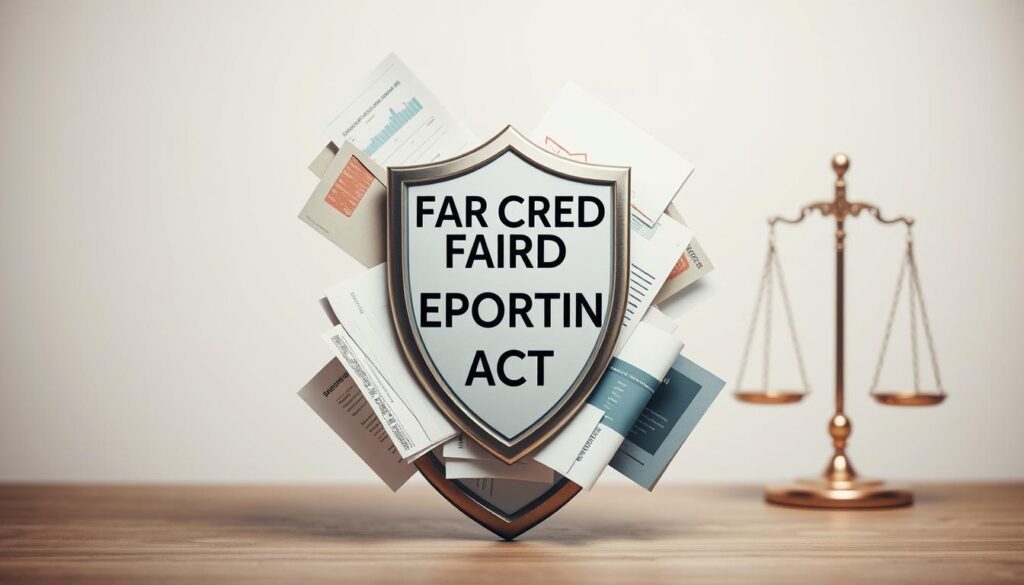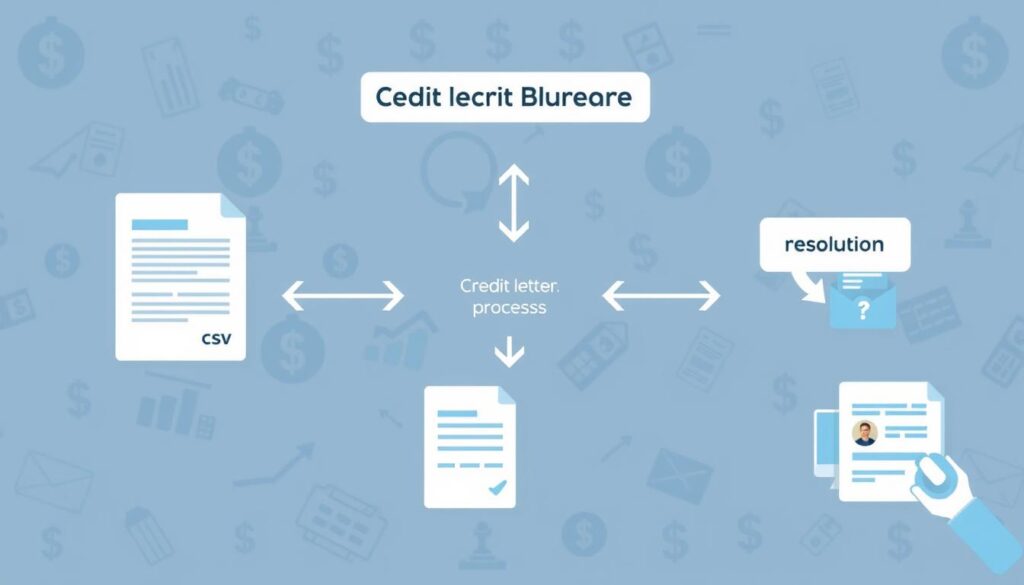A healthy credit profile is vital in our digital world. Your credit report affects loan approvals and interest rates. Sadly, credit report errors are common and can impact your financial future.
The 611 dispute letter is a powerful tool to address these issues. It helps you challenge inaccurate information on your credit reports. This tool can significantly improve your financial standing.
We’ll explore credit disputes and legal protections for consumers. You’ll learn about the Fair Credit Reporting Act (FCRA) and how to craft an effective 611 dispute letter. These skills will help you take control of your credit.
Key Takeaways
- A 611 dispute letter is a powerful tool for challenging inaccurate information on your credit report.
- The Fair Credit Reporting Act (FCRA) provides consumer protections and legal rights to dispute credit report errors.
- Properly formatted 611 dispute letters can compel credit bureaus to investigate and correct inaccuracies.
- Debt validation letters can help you challenge questionable debts and request verification from creditors.
- Ongoing credit monitoring and vigilance are essential for maintaining accurate credit information.
Understanding the Importance of Credit Dispute Letters
Your credit report greatly impacts your financial life. It affects your ability to get loans, rent homes, and even land jobs. Sometimes, these reports contain errors or inaccuracies that can hurt your credit scores.
The Role of Credit Reports in Financial Well-being
A credit report shows your credit history, including payment habits and debts. Lenders use this info to decide if they’ll lend to you. A higher credit score often means better loan terms and lower interest rates.
It also opens doors to more financial products like credit cards and mortgages. Your credit report can greatly affect your financial options.
Common Credit Report Errors and Inaccuracies
Credit reports aren’t always correct. Errors and inaccuracies can happen due to identity theft, mistakes, or unresolved disputes. These credit report errors can lower your credit score, making it harder to get loans.
Common credit report errors include:
- Accounts that do not belong to the consumer
- Incorrect payment histories or balances
- Outdated or unresolved disputes with creditors
- Duplicate entries for the same debt
A credit dispute letter can fix these errors. It helps ensure your credit report accurately shows your financial history. This can maintain a healthy credit score.
What Is a 611 Dispute Letter
A 611 dispute letter helps you fix credit report errors. It’s named after Section 611 of the Fair Credit Reporting Act (FCRA). This letter lets you challenge wrong info on your credit report.
The credit dispute letter tells credit bureaus to check and fix mistakes. It ensures credit agencies give you correct and timely credit info. This is key for your money health.
Key Features of a 611 Dispute Letter
- Identifies the specific credit report items that the consumer wishes to dispute
- Provides a clear explanation of why the information is inaccurate or misleading
- Requests that the credit bureau investigate the disputed items and provide a response within the mandated timeframe
- May include supporting documentation to substantiate the consumer’s claims
- Emphasizes the consumer’s rights under the FCRA to have erroneous information corrected
A good 611 dispute letter starts the credit fix process. It helps you take charge of your credit profile. This step lets you fix credit report errors.
It guards your money standing and credit score. You can protect your financial future with this letter.

| Key Advantages of a 611 Dispute Letter | Potential Outcomes |
|---|---|
|
|
Knowing about 611 dispute letters helps you keep your credit report right. It lets you fix errors and protect your money health. You can take charge of your credit profile with this tool.
The Fair Credit Reporting Act: Your Legal Rights
The Fair Credit Reporting Act (FCRA) protects consumers’ rights regarding their credit reports. This law lets people challenge mistakes on their credit reports. It helps safeguard their financial health.
Consumer Protections under the FCRA
The FCRA gives consumers important rights and protections. These include:
- The right to access their credit reports from the three major credit bureaus (Experian, Equifax, and TransUnion) for free once a year.
- The ability to dispute any errors or inaccuracies they find on their credit reports and have them investigated by the credit bureaus.
- The requirement for credit bureaus to investigate and correct any verified errors in a timely manner.
- Limitations on the types of information that can be included in a consumer’s credit report, such as outdated or unverified data.
- The right to be notified when negative information is added to their credit report.
These protections help people manage their credit report disputes. They ensure financial records are accurate. The FCRA safeguards consumer rights in credit reporting.

“The FCRA gives consumers the power to challenge and correct inaccurate information on their credit reports, which is essential for maintaining a healthy financial profile.”
Crafting an Effective 611 Dispute Letter
A well-crafted 611 dispute letter is crucial for challenging credit report errors. It formally requests credit bureaus to investigate and fix inaccuracies. By following a structured approach, you can create a compelling letter that upholds your FCRA rights.
Essential Components of a Dispute Letter
An effective 611 dispute letter should include these key elements:
- Identification Information: Provide your full name, current address, and any previous addresses associated with your credit file.
- Dispute Details: Clearly identify the specific inaccuracies or errors you are disputing, such as incorrect account information, fraudulent activity, or mistaken personal details.
- Supporting Documentation: Gather and include any relevant documents, such as payment receipts, account statements, or correspondence, to substantiate your dispute.
- Legally-Required Language: Incorporate the appropriate language to ensure your rights under the FCRA are protected, such as the requirement for the credit bureaus to investigate your dispute within 30 days.
- Desired Outcome: Explicitly state the outcome you are seeking, such as the removal of negative or inaccurate information from your credit report.
These components help create a thorough 611 dispute letter. Your letter will effectively communicate your case to credit bureaus. It will prompt them to take appropriate action on your behalf.

“Disputing inaccuracies on your credit report is a crucial step in maintaining a healthy financial profile. A well-crafted 611 dispute letter can be the key to resolving these issues and improving your creditworthiness.”
Credit Bureau Dispute Process
Ensuring your credit report’s accuracy is vital for your financial health. The credit bureau dispute process helps you correct errors. After sending a 611 dispute letter, credit bureaus must investigate and respond promptly.
This process involves several steps that credit bureaus must follow. They verify information and address your concerns within a set timeframe.
The credit bureau dispute process typically unfolds as follows:
- Submission of Dispute: You’ll submit your 611 dispute letter, either online, by mail, or through a credit monitoring service, outlining the specific inaccuracies or errors in your credit report.
- Investigation by the Credit Bureau: Upon receiving your dispute, the credit bureau will initiate an investigation, reaching out to the relevant data furnisher (such as a lender or creditor) to verify the disputed information.
- Response Timelines: The credit bureau has a limited timeframe, typically 30 to 45 days, to complete the investigation and provide you with the results. During this period, they must make a good-faith effort to resolve the dispute.
- Correcting Inaccuracies: If the investigation determines that the information in your credit report is inaccurate, the credit bureau will update or remove the disputed item, ensuring that your credit report accurately reflects your creditworthiness.
- Notification of Resolution: Once the investigation is complete, the credit bureau will notify you of the outcome and provide you with a free copy of your updated credit report, allowing you to verify the changes.
Understanding this process helps protect your financial well-being. It ensures your credit report accurately reflects your creditworthiness.
Regular monitoring and quick action on discrepancies can improve your credit profile. This can lead to better financial opportunities in the future.
| Credit Bureau | Dispute Investigation Timeframe | Notification of Results |
|---|---|---|
| Experian | 30-45 days | By mail or online |
| Equifax | 30-45 days | By mail or online |
| TransUnion | 30-45 days | By mail or online |

“Maintaining a healthy credit report is essential for achieving your financial goals. The credit bureau dispute process empowers you to take control of your credit history and ensure its accuracy.”
Debt Validation Letters: Challenging Questionable Debts
Debt validation letters are powerful tools for challenging unverified debts. They help ensure your credit report accurately reflects your financial history. Use them alongside disputing inaccurate information on your credit report.
Requesting Verification of Disputed Debts
The Fair Credit Reporting Act (FCRA) gives you the right to verify debts on your credit report. You can compel creditors to prove a debt’s legitimacy by sending a debt validation letter.
A validation letter should clearly identify the disputed debt. It should ask the creditor to provide proof of the obligation. This process helps with erroneous debts or those beyond the statute of limitations.
- A debt validation letter should clearly identify the disputed debt and request that the creditor provide documentation to validate the obligation.
- This process can be particularly helpful if you believe the debt is erroneous, has been paid, or is beyond the statute of limitations.
- If the creditor fails to respond or cannot provide adequate documentation, the debt must be removed from your credit report.
Combining validation letters with 611 dispute letters is a strong strategy. It addresses both inaccurate information and questionable debts. This proactive approach helps you regain control over your financial history.
“Debt validation letters can be a game-changer in cleaning up your credit report and ensuring it accurately reflects your financial situation.”
Credit Repair Strategies for Optimal Results
A 611 dispute letter is key for credit repair. It’s the first step to fix errors. But it’s not the only way to boost your finances.
A full plan tackles the root of credit report errors. It also helps improve your credit score. Regular credit report checks are vital.
Quick spotting of new issues keeps your credit healthy. This active approach helps you stay on top of problems.
- Regularly review your credit reports from all three major credit bureaus (Experian, Equifax, and TransUnion)
- Dispute any errors or inaccuracies you find, following the process outlined in the previous section
- Ensure that resolved disputes are accurately reflected on your credit reports
Tackle money issues that cause low credit scores. Pay down debts and make a budget. Work on your payment history.
Fixing these problems leads to lasting credit score growth. It also helps you gain long-term money stability.
Credit repair strategies need ongoing work. Mix dispute methods with active credit checks. Add solid money management for the best results.
Monitoring Your Credit Reports After Disputes
After sending a 611 dispute letter, keep a close eye on your credit reports. Accurate credit information is vital for a healthy financial profile. Stay vigilant to avoid potential issues.
Ensuring Accurate Credit Information
After disputing, track the investigation and verification process closely. Credit report monitoring helps confirm that incorrect information has been removed. It also ensures your report reflects the correct data.
Regularly check your reports from Equifax, Experian, and TransUnion for credit report accuracy. Look for remaining errors or new inaccuracies that may have appeared. If you find unresolved issues, start additional disputes right away.
- Regularly review your credit reports from all three major bureaus (Equifax, Experian, and TransUnion) to ensure credit report accuracy.
- Carefully examine your credit reports for any remaining errors or new inaccuracies that may have arisen during the credit dispute follow-up process.
- If you find any unresolved issues, promptly initiate additional disputes to ensure your credit profile is free of errors.
Constant monitoring of your credit reports protects your financial health. It ensures your credit history accurately shows your creditworthiness. This practice is key to maintaining a strong financial position.
“Regularly reviewing your credit reports is the best way to catch and correct any inaccuracies or fraudulent activity on your accounts.”
Conclusion
A 611 dispute letter is a powerful tool for consumers. It helps challenge wrong information on credit reports. This letter protects your financial well-being and enforces your rights under the law.
You can effectively dispute credit report errors using the strategies we’ve shared. This safeguards your consumer rights and opens doors to better financial opportunities. You may secure better loans, rent a home, or even land a job.
Your credit report is vital to your financial profile. Keeping it accurate is key to your overall financial health. Address any credit report inaccuracies through the 611 dispute process.
Taking action now can lead to a more secure financial future. Don’t hesitate to use this tool to protect your interests.

